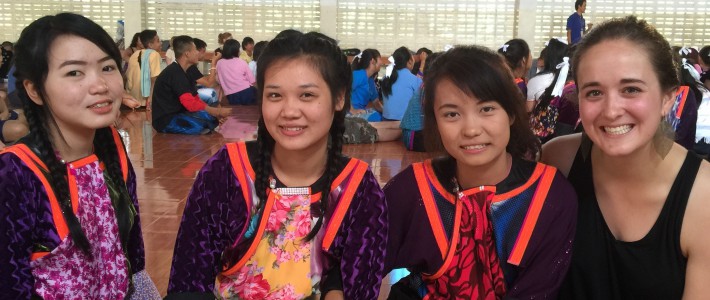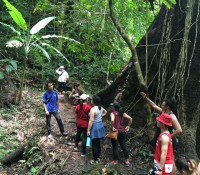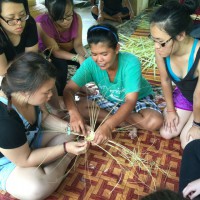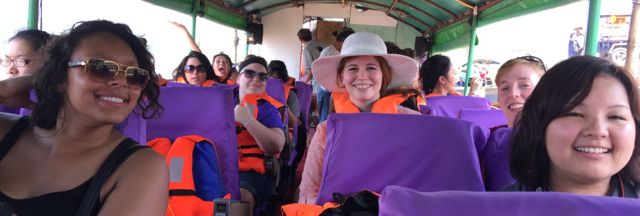
Reflecting on her twenty years of teaching and her long-term goals for pedagogy and practice, Linda Buturian (PsTL) explains why the learning abroad program she developed in partnership with Cathy Solheim (FSoS) epitomizes her ongoing quest.
“Thailand comes the closest to my ideal of a teaching and learning environment: Engaging in socially relevant topics in an applied experiential learning in a small community that’s interactive with communities, and in natural places,” says Buturian.
Buturian has been trying to recreate what she experienced as an undergraduate while living and studying in community with a handful of peers and professors in the mountains of Oregon. “We lived in cabins and studied the big ideas together,” she recalls. “We read Jacques Ellul’s The Technological Society then traveled to San Francisco and experienced it. We read Annie Dillard and Wendell Berry, discussed the importance of wilderness, then backpacked into the Three Sisters in the Oregon Cascades.
 During three weeks in May of 2015, Buturian and Solheim brought 20 students to Thailand to study the impact of globalization on environmental sustainability, economic and family well-being and community development as it relates to changes along the Mekong River. The program braids Buturian’s research on and interest in international rivers and her experience using digital stories for teaching and learning, with Solheim’s extensive knowledge of Thai culture and family social sciences scholarship. “To design a course with Cathy and experience this transformative learning with the students was profound to me.”
During three weeks in May of 2015, Buturian and Solheim brought 20 students to Thailand to study the impact of globalization on environmental sustainability, economic and family well-being and community development as it relates to changes along the Mekong River. The program braids Buturian’s research on and interest in international rivers and her experience using digital stories for teaching and learning, with Solheim’s extensive knowledge of Thai culture and family social sciences scholarship. “To design a course with Cathy and experience this transformative learning with the students was profound to me.”
While in Thailand, the curriculum involved fieldwork, individual student blog posts and a group blog project. Buturian and Solheim wanted topics for the group project to emerge from the trip’s main activities:
Visiting with the students at the Suksasongkroh Chiang Dao School, a boarding school that provides children from some of the poorest hill villages a chance to escape human trafficking and poverty;
Interacting with students and community leaders at the Mekong River School, which is dedicated to helping young people maintain and learn about their cultural traditions, including protecting and cherishing the natural environment and resources of the Mekong River;
 And, a homestay at Mae Kampong, a strong village community that derives income from tea, coffee and its eco-homestay program.
And, a homestay at Mae Kampong, a strong village community that derives income from tea, coffee and its eco-homestay program.
An unexpected and emotional connection occurred during a discussion with one of the tour guides, Eve. She shared her personal stories about the effects of human trafficking on her family and friends. Eve grew up in northern Thailand in the Golden Triangle in a poor area and told the students about aunts, cousins and friends who were sold into sex trafficking operations in Bangkok. Many have died of HIV. Eve’s mother encouraged her to “be the best” at her school and Eve received a scholarship as the top girl in her class that allowed her to elude this fate. The second ranked girl was trafficked and later died.
To unpack the broad subject of globalization and identify group blog topics, the class held a three-hour meeting. “We had some ideas of what the topics would be, but we wanted the students to choose and articulate them and group themselves based on their interests,” says Buturian. As a class, they settled on: globalization and human trafficking; globalization and its impact on the environment, primarily on the Mekong River and the villagers who live along the river; and, globalization and education. The topic of Buddhism also emerged based on an engaging talk presented by a Hmong Buddhist monk in Chang Mai. Coalescing around interest, students combined research, interviews, reflections and images to develop their group blogs. This work set the stage for the final individual project to be completed once the students returned home: a digital story reflecting on what they learned through their experiences.
Buturian, who has been using digital stories since 2008, defines them as 5-10 minute movies students create and share online, using images, audio and text. She realized the level of student engagement with the genre early on: recognizing it harnesses students’ visual knowledge while also providing a shareable end product. “I started to gather the research as to why digital stories were working,” says Buturian. Bloom’s Revised Taxonomy, which classifies creating as higher-order thinking, helped to shed light on why creating the digital story is both challenging and potentially transformative. “This is a creating act. This is why it is both hard and rewarding.”
The students’ digital stories incorporate personal reflections and photographs from their time in Thailand. Buturian and Solheim were mindful to assign the digital story once students had returned to campus to ensure the students weren’t sidetracked by technology and miss chances to learn and connect while in Thailand.
“Students will be navigating the complex challenges and opportunities that come along with globalization,” says Buturian. “As teachers, it is incumbent upon us to provide hopeful, collaborative models and experiences to help students not only envision more sustainable and just societies, but to realize the power and joy of participating in creating those communities.”
Thailand 2015 student blogs and digital stories can be found here.




